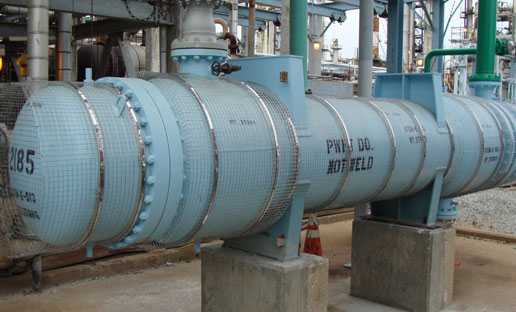BENEFITS:
Ease of and more
thorough Inspection
thorough Inspection
Governmental, company, and local jurisdictional codes and standards derive inspection requirements. Most refineries reference and adhere to API 570 as a minimum. This document instructs many requirements but gives specific instruction for the frequency of inspection for certain types of systems. The more dangerous or volatile the service, the more frequent the inspection. And the location (over a road, rail crossing, or waterway) the more frequent the inspection. The most common types of post construction documented required inspection in a refinery are visual and Ultrasonic Thickness (UT) readings.
Under insulation, these readings used to be taken by cutting a hole in the insulation shell, removing the jacket and the insulation, cleaning the surface, then taking and recording the reading. After the reading was taken, the insulation needs to be replaced then a mastic, caulk, tar, or sealant is applied to cover the penetration to prevent moisture infiltration. Today this is achieved by both the traditional method and by the use of pre-installed inspection test ports/plugs.
Unfortunately, the locations where the inspections are performed have mastic dry and crack and the more advanced plugs get weathered and dry and allow water into the system. API 570, the same inspection code that requires regular thickness readings, suggests that inspectors pay particular attention to the location that have been tested before for this very reason.
The reason for the inspection testing is to prevent an incident from occurring because we know from catastrophic experience that pipes and vessels corrode and lose their ability to hold pressure by the reduction of metal thickness. Occasionally we receive a thickness reading below or at the allowable minimum wall thickness. Then, the inspection group is typically required to evaluate the severity and bring it to the attention of upper management. Management decides if they should shut the unit down immediately, schedule a pushed forward shutdown, or wait until the next scheduled shutdown to repair the vulnerable circuit. Whatever the decision, the insulation has to be removed and inspection performed until you reach thick enough material to make the connection. With the Envirocage system, a complete visual is possible at any time. With the Envirocage system, UT thickness readings are less labor intensive, faster, and more thorough. The inspector can also inspect more locations other than the same place as before if they prefer.
 With the Envirocage system, you will not be creating locations for moisture to infiltrate the system.
With the Envirocage system, you will not be creating locations for moisture to infiltrate the system.
Under insulation, these readings used to be taken by cutting a hole in the insulation shell, removing the jacket and the insulation, cleaning the surface, then taking and recording the reading. After the reading was taken, the insulation needs to be replaced then a mastic, caulk, tar, or sealant is applied to cover the penetration to prevent moisture infiltration. Today this is achieved by both the traditional method and by the use of pre-installed inspection test ports/plugs.
Unfortunately, the locations where the inspections are performed have mastic dry and crack and the more advanced plugs get weathered and dry and allow water into the system. API 570, the same inspection code that requires regular thickness readings, suggests that inspectors pay particular attention to the location that have been tested before for this very reason.
The reason for the inspection testing is to prevent an incident from occurring because we know from catastrophic experience that pipes and vessels corrode and lose their ability to hold pressure by the reduction of metal thickness. Occasionally we receive a thickness reading below or at the allowable minimum wall thickness. Then, the inspection group is typically required to evaluate the severity and bring it to the attention of upper management. Management decides if they should shut the unit down immediately, schedule a pushed forward shutdown, or wait until the next scheduled shutdown to repair the vulnerable circuit. Whatever the decision, the insulation has to be removed and inspection performed until you reach thick enough material to make the connection. With the Envirocage system, a complete visual is possible at any time. With the Envirocage system, UT thickness readings are less labor intensive, faster, and more thorough. The inspector can also inspect more locations other than the same place as before if they prefer.
With the Envirocage system, if there is a problematic circuit, the inspection to find good material is faster and easier as well as the verification of all 360 degrees
- It does not require insulation personnel to perform work prior to the inspection.
- It does not require the waste of the insulation.
- It does not require replacement of insulation.
- It does not leave the establishment vulnerable to burns during the period before repair.

